Python is a general-purpose programming language released in 1991 that has been giving a tough fight to its competitors in the market ever since its release. Large-scale and futuristic Software models utilize Python as a critical technology to develop applications for different purposes.
Python can be used for web development, scientific and numeric computing, creating desktop GUIs, software development, and developing eCommerce or ERP apps. With such an extensive application domain, it remains the most compatible and rich-featured technology.
Web development is the process dedicated to creating websites or web-based applications. From dynamic websites to progressive web apps, web development has come a long way through its journey from technological evolutions led by technology leaders of the market.
The incorporation of python into web development helped web developers all across the world to indulge in increased readability, simplicity, and efficiency.
How Is Python Used in Web Development?
Python is a server-side programming language. It means a Python development company can use Python to code server-side web apps because web browsers do not compile Python but JavaScript. If you are new to web development, you need to understand the structure of a web app.
If you are developing a web app, you need client-side language to write your code for browser executing which shows the frontend of your application. If you want to store data or access stored data on the server, you will then need a server-side programming language such as PHP, Python, Ruby, Java, etc.
Most web developers use the combination of Python and JavaScript to create the entire structure of web apps where Python’s code runs on the server, JavaScript’s code runs on the client-side or web browsers.
Python provides web developers open-source libraries for creating web applications.
Python Frameworks for Web Development
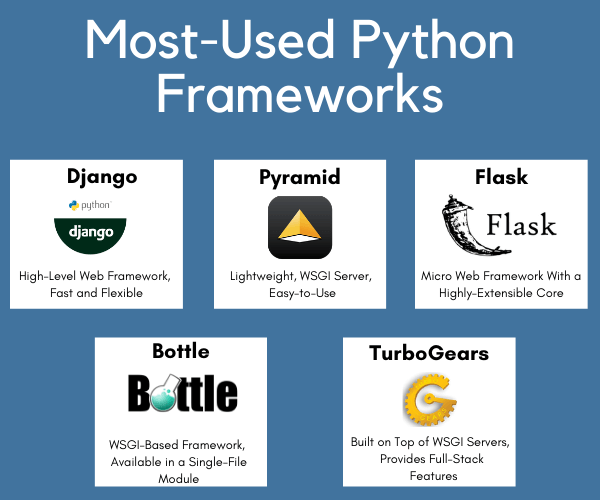
The goal of using frameworks is to simplify the code and build web applications with more ease and speed. Python frameworks allow indulging in encapsulated code of basic HTTP-related and other important operations which include;
- URL Routing
- Web Form Validation
- Generate output formats i.e. HTML, XML, JSON, PDF
- Database connection & manipulation
- Enable web security tools
- Session storage and retrieval
Is it necessary to use a framework to develop web apps using Python? No, it is not. But, it certainly simplifies the efforts.
Still, you can not completely rely upon the framework. There can a few functionalities that may or may not exist in some of the frameworks. Though all the frameworks follow batteries included approach where they feature everything possibly required by the developers, they can integrate small packages to extend it to the advanced functionalities.
Here are some of the most used Python web frameworks;
Django
It is a high-level web framework based on Python. It is widely used because of the rich stability and performance of its code. It has a large community of developers. There are several upgrades indulged in the functionalities of this web framework. The most popular of those upgrades are its database migration and documentation features.
Pyramid
It is a Python-based web framework build on top of a WSGI server. It follows the mode-view-controller architecture for developing engaging web app UIs. The configuration of web apps developed through the Pyramid framework is considerably more intense than other frameworks. The main operations of the Pyramid framework include templating and enabling strong web app security.
Flask
It is a Python-based micro web framework that indulges in a highly-extensible core to the applications. It utilizes subclassing for enabling rich customization in the web app code. It has features to counter a significant security issue, cross-site scripting (XSS) where cyber attackers manipulate malicious code on the client-side web app and provide a security cover.
Bottle
It is a WSGI-based, micro web framework, available in a single-file module. It engages in no dependencies except on Python’s extensive standard library. Its main functions include routing, templating, the formation of utility documents, and providing support for HTTP development and other servers.
TurboGears
It is the most flexible web framework built on top of WSGI servers. It indulges in full-stack features of a web framework required to develop a web application. Through its minimal mode, it allows web app developers to use it as a micro web framework where the stack is available as per the requirements of the code environment. It supports MongoDB as its primary database server.
All of the web servers discussed in this section can be used to create scalable, credible, and easy-to-manage web applications.
What Are the Steps to Python Web Development?
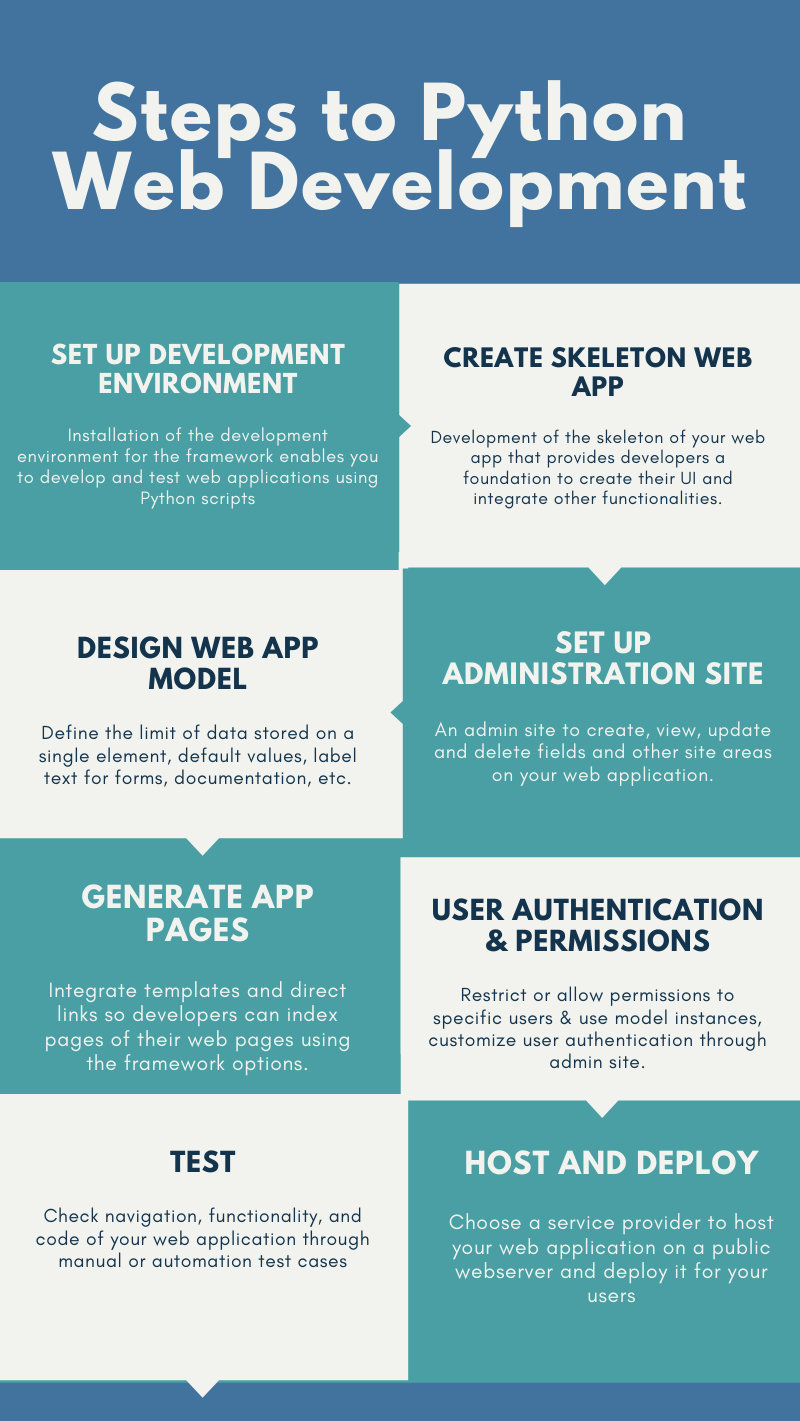
To add functionalities to your client-side web app, you can utilize a combination of JavaScript and Python.
Python will enable you to decide what content and functionalities you want to offer on your website. The Python code executes on the server-side whereas JavaScript runs on the client-side.
Setting Up Development Environment
You can use any Python framework to write the server-side code for your web app. You first need to set up the environment for the framework you are going to adopt. You can download and configure the framework on your operating systems such as Windows, Linux (Ubuntu), or macOS.
Installation of the development environment for the framework enables you to develop and test web applications using Python scripts. Developers can utilize an independent Python virtual environment to code their app using the framework. Such an approach eliminates the dependencies of your web applications on a particular version of the framework you are using.
Creating a Skeleton Web App
Before we move to design the user interface of the web app, we need to enable site-specific settings, define a complete URL path, and add model, view, and templates.
To begin, web design services providers start by creating a new project and templates. The python-based framework allows web developers to create separate application projects for separate web app components.
These applications are then integrated with different paths to their respective applications. After routing the URL to different view pages, developers run database migration on the skeleton web app to evaluate the stability of data stored.
Here is how we accomplish the development of the skeleton of your web app that provides developers a foundation to create their UI and integrate other functionalities.
Create & Design Web App Model
Models are the components of a web app that engage in the structure of data to be assigned. It defines the limit of data stored on a single element, default values, label text for forms, documentation, etc.
After integrating a database, you can use the framework to set up the communication between the web app and the server.
Set Up Administration Site
Python web framework provides developers an admin site to manage site areas of your web app. Developers can create, view, update, and delete fields on your web application.
It is a compatible approach to manage the data on your web app as per the type of website you are going to develop.
Web app developers engaged in the development can access the admin site using /admin URL.
Alongside managing fields and views, developers can also register or define the ModelAdmin class to customize the appearance of models on the interface of the web application.
Generating App Pages
It starts with mapping the URLs. Most of the URL mapping would have already been done while creating the skeleton of the web app. However, developers can define the resource URLs by encoding information in the body. URL mapper will utilize this information to call view and integrate data from the database.
The view function sends an HTTP request to the database to fetch the data. Database renders the data to an HTML page through an HTML template. Then, it sends back the viewable HTML page to the users.
By integrating templates and directing links, developers can index pages of their web pages using the framework options.
User Authentication & Permissions
Developers can integrate different sessions on the application for different user accounts. To help the users start or stop the session which is log in or log out for them, developers can utilize the Python framework’s admin site to create users and groups.
By adding a new user group, you can use validation code to integrate user authentication. There are templates available to integrate login, logout or password reset pages.
To restrict or allow permissions to specific users, developers can use model instances. Moreover, developers can add, update or disable permissions through the admin site.
Testing
To check navigation, functionality, and other things on your web application, testers can utilize manual or automation testing. While manual tests require testers to check and execute the code manually, automated tests indulge in a more visualized form of testing.
There are three most significant types of tests to be performed on a web application;
- Unit Tests
Part your code in class and function levels and test their individual functions as a unit.
- Integration Tests
Integrate different parts of the web application and test their functionality together.
- Regression Tests
Tests to detect any erroneous impacts of tests performed on other parts of the web app.
There are tools to test web apps in the Python ecosystem, namely, Green (test runner), Requestium (Python library that can be merged with Selenium), and Coverage.py (Measures code coverage).
Moreover, Pytest is a complete testing framework based on Python. It is used to write manual test cases.
Host and Deploy Your Python Web Application
There are plenty of hosting services providers you can choose from to host your web application on a public webserver.
Generally, these hosting service providers offer four types of service architectures;
- “Bare metal” servers
- Virtualized servers
- Infrastructure-as-a-service (IaaS)
- Platform-as-a-service (PaaS)
Most of the hosting service providers offer an Infrastructure-as-a-service type of server. While choosing Platform-as-a-service can reduce maintenance overhead and indulge in a simpler scaling, Infrastructure-as-a-service is preferred for more flexible deployment.
Why Is Python The Best Choice For Web Development?
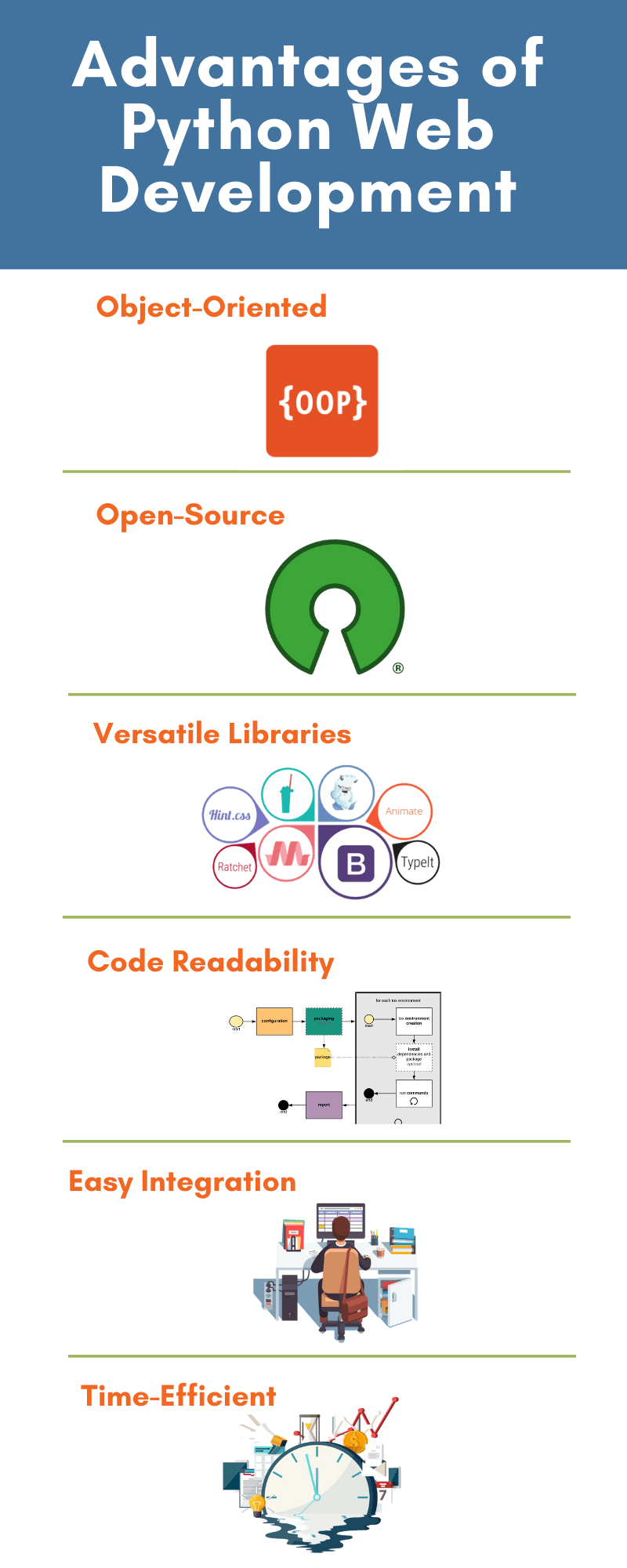
There are plenty of reasons for Python being everyone’s favorite programming language. Someone calls out for its easy syntax, the other one says it is rich-featured.
Let’s find out what makes it a leading choice as a server-side language for web development.
Object-Oriented
Python becomes time and cost-efficient because of being an object-oriented programming language. In web development, it facilitates web app or website development services providers to utilize their resources in other important components of web apps.
Those who keep looking for Python vs PHP, can realize that PHP does not follow OOP concepts completely. It makes PHP face a few issues in web development.
Open-Source
It is free and open-source. It is one of the most significant reasons why it is such a popular server-side programming language. Being open-source helps Python keep upgrading.
Versatile Libraries
Open-source standard libraries are the reason why the development of large-scale web apps becomes dramatically simpler through Python.
Easy-To-Read
As mentioned earlier, it has an easy syntax. Its well-formatted syntax and documentation make the source code more clear and readable.
Smooth Integration
Python is highly suitable for integrating third-party code, OSs, and standard libraries. It makes itself a popular choice for web development where it is highly probable to use third-party integration to make web app rich-featured putting in fewer efforts.
Development Time
Rich-compatibility, simplified and independent code approach, versatile options indulge in a speedy development using Python and its frameworks.
There are many other top reasons for choosing Python for world-class web development that the server-side programming language more developer-friendly.
How Much Does It Cost to Develop Web Applications Using Python?
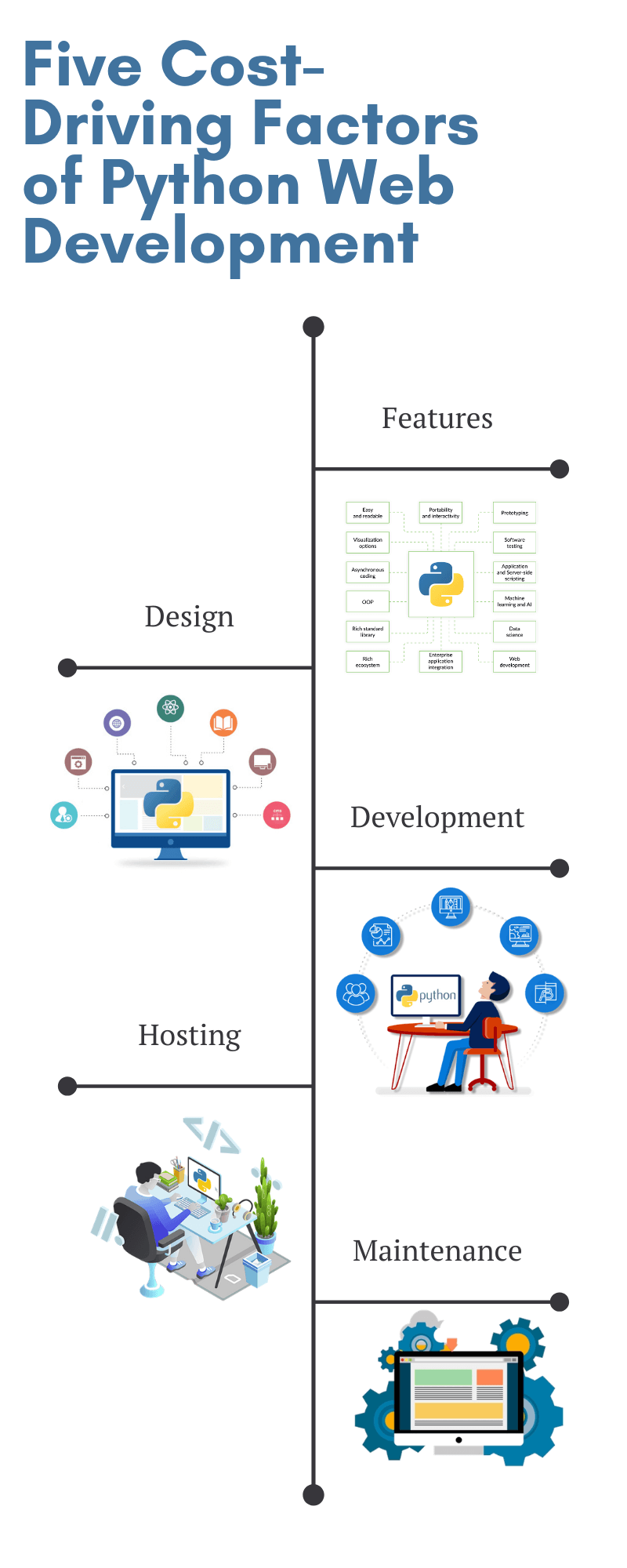
It would not be the right approach to keep pricing in a range or provide you a constant value of the cost to develop web apps using Python.
There are several cost-driving factors that define the total estimate such as;
- Features
- Design
- Development
- Hosting
- Maintenance
Alongside this, there is one more factor that actually does not directly relate to the development process and it is geographic location. There can be significant differences in the manpower you hire from one location to another.
For example; availing of Python development services from an APAC country like India or Pakistan can be cheaper than hiring from any western country like Canada or the United Kingdom.
Most Popular Web Apps Developed Using Python
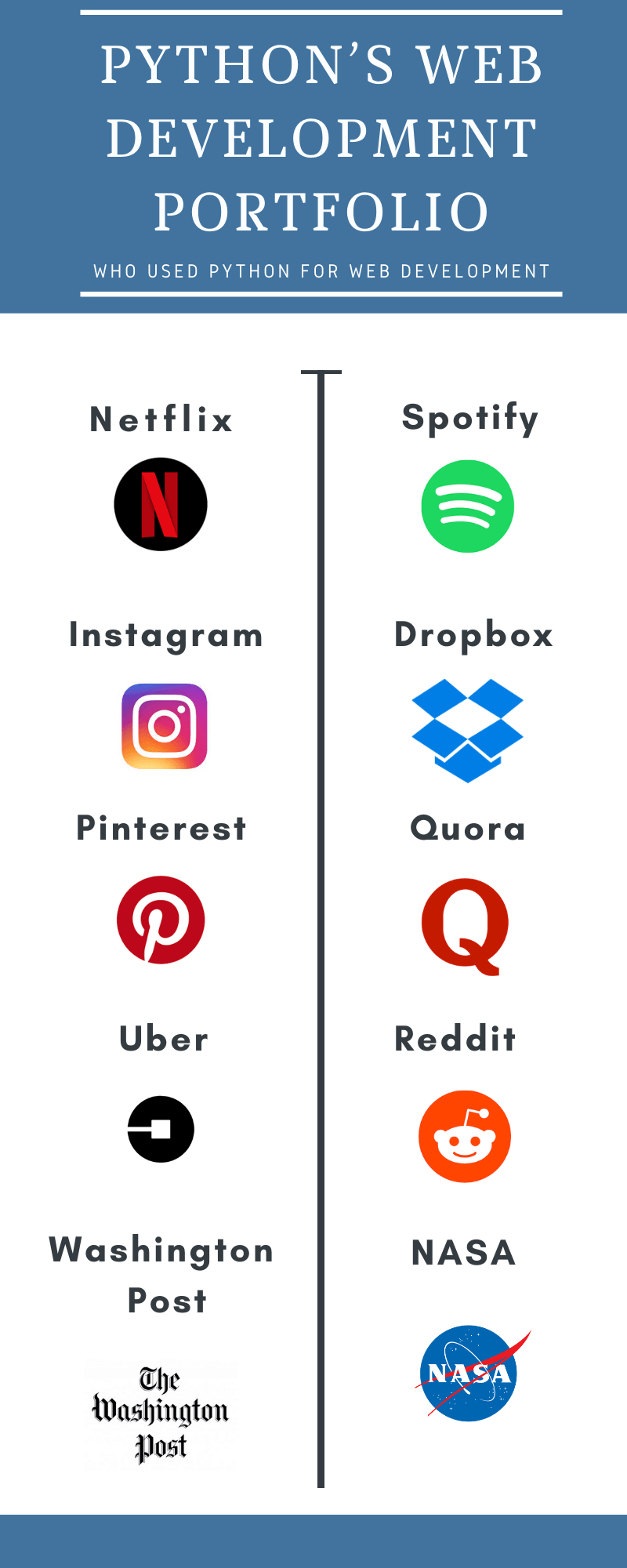
If you still have any doubts left in your mind on why you should choose Python for developing your web application, maybe its portfolio of top ten companies that used it for web development can help you comprehend it better.
These are the ten most popular organizations that used Python in their web applications.
- Netflix
- Spotify
- Dropbox
- Uber
- Quora
- Washington Post
- NASA
And, there are many more.
Reports & Statistics on Python Web Development

- 84% of developers using Python consider it as their primary language.
- 60% of users prefer using Python for work as well as for personal use. 19% of users use it only for work.
- 52% of users use Python for web development with other purposes.
- 27% of users use Python for web development alone (more than any other purposes).
(Source: JetBrains’ Python Developers Survey)
Conclusion
Python web development has emerged as a shiny trend in the market. It has overpassed most of its competitors on several scales. We tried to cover every single aspect of Python web development through this guide. The objective was to bring you closer to Python and its evolving application in web development. To understand and comprehend it better or discuss your project, you can consult a Python development company.





